

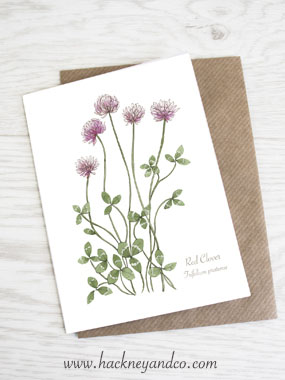
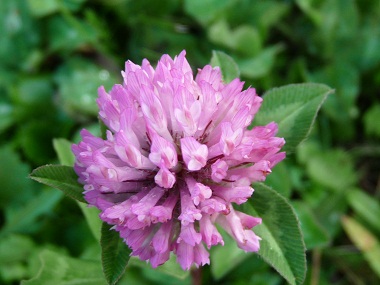

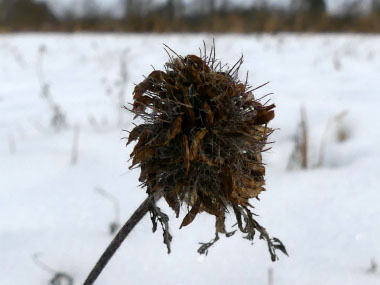
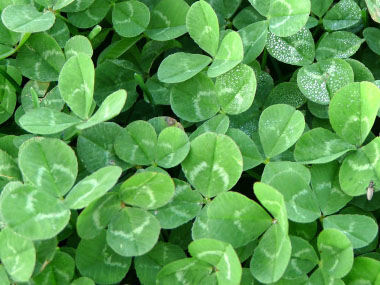
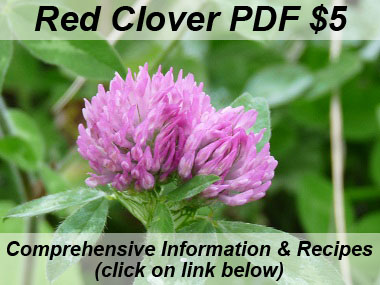
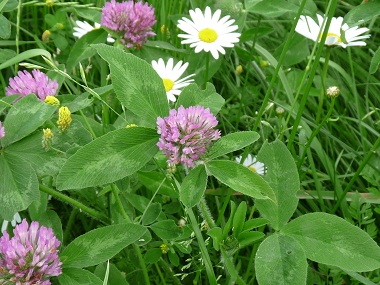
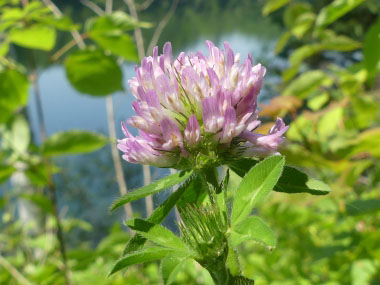
For comprehensive information (e.g. nutrition, health benefits, recipes, history, harvesting tips, etc.) please check out our Red Clover PDF magazine.
Red clover is a wild edible plant belonging to the legume family that is commonly used as food for cattle. This common edible plant has a long and colourful history. Traditional Chinese medicine believed that it was a good tonic for colds, to purify the blood, and at one time they burned it as incense. Native Americans used it as a salve for burns, as well as for bronchial problems. Many cultures have traditionally used red clover to treat whooping cough, respiratory problems, psoriasis, eczema and even cancer. Red clover is one of the herbs in Essiac, and grows in many areas around the world.
Distinguishing Features
Red clover is very distinct as it has a reddish round flower head made up of numerous tubular-shaped flowers. Its green leaves have a white or pale green chevron on the upper side which helps to guide pollinator insects to the flower head.
Flowers
Each flower head is about 2-3 centimetres across and consists of numerous tiny flowers. These flowers are tubular-shaped, and spread outward in different directions. Each flower has 5 narrow petals that are pink or purplish pink, becoming light pink or white toward the base of the flower head. The blooming period usually starts about late spring and can continue, depending on weather right through to late October.
 Fields
of Nutrition has medicinal benefits and vitamin/mineral content of Red Clover.
Fields
of Nutrition has medicinal benefits and vitamin/mineral content of Red Clover.
Leaves
The leaflets are oval or ovate and tend to be broader in the middle. Toward the centre of the upper surface of each leaflet, there is usually a chevron that is white or very pale green. At the base of each compound leaf, there is a pair of ovate stipules. Usually there are 1-3 leaflets immediately beneath each flower head, as well as several green bracts.
Height
Depending on conditions, red clover plants can grow up to 80 centimetres in height.
Habitat
Habitats include fields, pastures, vacant lots, grassy areas along roads, weedy meadows and on front and backyard lawns.
Edible Parts
Although leaves can be tossed into a salad or used in a tea, the preferable part of this wild edible is the flower. Red clovers are the tastiest of all clovers although it is recommended not to eat too many of these as some people experience bloating.
Other Name
Purple Clover.
Similar Plants
Recipes
Burdock Tonic Tea, Clover Syrup, Herbal Shampoo, Leek and Nettle Soup, Red Clover Biscuits, Red Clover Ice Tea
To support our efforts please browse our store (books with health benefits, etc.).
Winter Survival Food Handbook

PDF Plant Magazines
Types of Wild Food
Geographic Zones Seasons
Disclaimer
EdibleWildFood.com is informational in nature. While we strive to be 100% accurate, it is solely up to the reader to ensure proper plant identification. Some wild plants are poisonous or can have serious adverse health effects.
We are not health professionals, medical doctors, nor are we nutritionists. It is up to the reader to verify nutritional information and health benefits with qualified professionals for all edible plants listed in this web site. Please click here for more information.
Why Edible Wild Food?
- Food costs are rising
- Free, wild food is readily abundant
- Wild food adds nutrition to your diet
- Wild food can help treat various medical conditions





